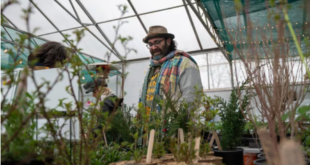Leap seconds have been added to clocks for decades, but with Earth’s rotation slowing, it may not be enough.

The leap year is the most famous of the leap family, keeping our calendars right every year, while behind the scenes, with little fanfare, the leap second has been doing its part.
But global stakeholders believe it’s time for a change — the leap minute.
“Ever since we’ve invented clocks, we’ve been having to make sure that they are keeping us relative to the sky,” Rob Cockcroft, an assistant professor of physics and astronomy at McMaster University in Hamilton, Ont., told host Matt Galloway on The Current.
Under our noses, the Earth’s rotation has been slowing down ever so subtly, putting our atomic time slightly out of sync with solar time. Cockcroft says back in the time of dinosaurs, a solar day only lasted about 23 hours.
Leaps years, like 2024, help keep us in line by adding an extra day to our calendar, usually every four years at the end of February. But Cockcroft says we need leap seconds, “so that we don’t end up eating lunch at midnight.”
“It would take us a very long time, longer than one person’s lifetime, to get there. But that would be the end result if we didn’t account for leap seconds.”
He says there are a number of factors for that slowing rotation, but one is connected to climate change. As glaciers melt, he says the rock they were weighing down starts to rise, and the distribution of the weight on Earth changes, affecting the spin rate.

In 1972, it was leap second to the rescue. According to Scott Beattie from the National Research Centre’s Metrology Research Centre, about 30 leap seconds have been added over the years.
The International Earth Rotation and Reference System Service, which tracks the difference between the solar day and our atomic time, watches to see if a leap second is needed. If there is a difference, the International Bureau of Weights and Measures (IBWM) adds a second at either the end of December or the end of June.
Beattie says when you should add a leap second isn’t predictable, as it requires calculating the speed of the earth’s rotation, and no leap second is currently scheduled for 2024.
The leap minute
Cockcroft says even once it’s decided that you need a leap second, there’s more work to do. Stakeholders include astronomers, geographers, telecommunication companies and many more.
“When it is announced, then you’ve got to update all of your systems to allow for this extra second,” Cockcroft said.
The IBWM, which will make a decision on this, is considering two possible solutions.
Beattie says one is to just stop caring about the leap second. Some day, we might notice the difference between our atomic clock and the solar clock, but it would take a long, long time.
“It would be a very, very small shift. But a lot of people really think it’s important to keep our time tied to solar time,” Beattie said.

The other option is the leap minute. Instead of going through the hassle of adjusting our clocks for a second every once in a while, we could let that time build up until it equals a minute, and then add it all to the atomic clock in one lump sum.
“Now we only have to do these corrections every, let’s say, 50 or 100 years,” Beattie said. “It certainly has a lot of appeal to a lot of people. We keep the link to solar time, but we minimize the disruptions to our timing systems.”
What’s more, he says our technology for tracking time will likely be better by then.
But don’t expect a decision right this second. The IBWM is expected to come up with a proposal on what to do and when to do it by 2026.
Whatever happens, Beattie says it’s important the world is on the same page. He says so many things require precise time, including financial markets, energy grids and navigation devices.
“We can’t have ambiguity at the level of seconds. And so the real key is to make sure we’re all talking about the same thing, we agree on something. And that we’re on the same page,” Beattie said.
ABOUT THE AUTHOR
Philip Drost is a journalist with the CBC. You can reach him by email at philip.drost@cbc.ca.
Interview with Rob Cockcroft produced by Amanda Grant
*****
Credit belongs to : www.cbc.ca
 Atin Ito First Filipino Community Newspaper in Ontario
Atin Ito First Filipino Community Newspaper in Ontario







